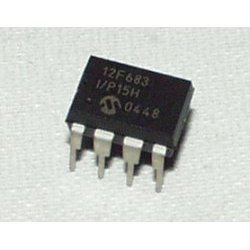×
SparkFun will be closed on Tuesday, December 24th, and Wednesday, December 25th, in observance of the Christmas holiday. Any orders qualifying for same day shipping placed after 2:00 p.m. (MST) on Monday, December 23rd, will be processed on Thursday, December 26th, when we return to regular business hours. Wishing you a safe and happy holiday from all of us at SparkFun!
Please note - we will not be available for Local Pick up orders from December 24th-December 27th. If you place an order for Local Pick-Up we will have those ready on Monday, December 30th.
PIC 8 Pin 20MHz 2K 4A/D - 12F683
New 8-pin PIC with nanoWatt technology. Extended WDT, 4 channel ADC, software selectable oscillator 32khz to 8MHz. Runs up to 20MHz with external crystal and up to 8MHz with an on-board RC oscillator. Package can be programmed in circuit.
PIC 8 Pin 20MHz 2K 4A/D - 12F683 Product Help and Resources
Core Skill: Soldering
This skill defines how difficult the soldering is on a particular product. It might be a couple simple solder joints, or require special reflow tools.
Skill Level: Rookie - The number of pins increases, and you will have to determine polarity of components and some of the components might be a bit trickier or close together. You might need solder wick or flux.
See all skill levels
Core Skill: Programming
If a board needs code or communicates somehow, you're going to need to know how to program or interface with it. The programming skill is all about communication and code.
Skill Level: Competent - The toolchain for programming is a bit more complex and will examples may not be explicitly provided for you. You will be required to have a fundamental knowledge of programming and be required to provide your own code. You may need to modify existing libraries or code to work with your specific hardware. Sensor and hardware interfaces will be SPI or I2C.
See all skill levels
Core Skill: Electrical Prototyping
If it requires power, you need to know how much, what all the pins do, and how to hook it up. You may need to reference datasheets, schematics, and know the ins and outs of electronics.
Skill Level: Competent - You will be required to reference a datasheet or schematic to know how to use a component. Your knowledge of a datasheet will only require basic features like power requirements, pinouts, or communications type. Also, you may need a power supply that?s greater than 12V or more than 1A worth of current.
See all skill levels
Comments
Looking for answers to technical questions?
We welcome your comments and suggestions below. However, if you are looking for solutions to technical questions please see our Technical Assistance page.
Customer Reviews
No reviews yet.


I wish there were more tutorials for these things...
I'm currently working with Microchip's MPLAB X under OSX with the xc8 compiler. I'm using a PicKit 3 as a programmer. I've made good progress towards getting the software UART implementation working and will write up a tutorial on it once I get it a bit more stable.
These chips are pretty cool for such a small device! Too bad there isn't an Arduino/Wiring type IDE for them...
Hello, how many LED can you connect on each I/O pin ?
Because in my project I would to connect 7 LED on each I/O pin ... it's to much ?
PS : sorry for my bad english ... I'm french
Use the pin to toggle a FET, that way the FET is sinking/sourcing the current, not the ucontroller
25mA maximum per pin, 90mA total per device.
A typical LED draws 20mA, so only 1 LED per pin, and only 4 total for the device. You can make the LEDs dimmer by limiting the current, but you'll never get 7 on one pin and be able to see the light. You'll have to use the pin to drive an external transistor.
When will you be getting more of these in stock?